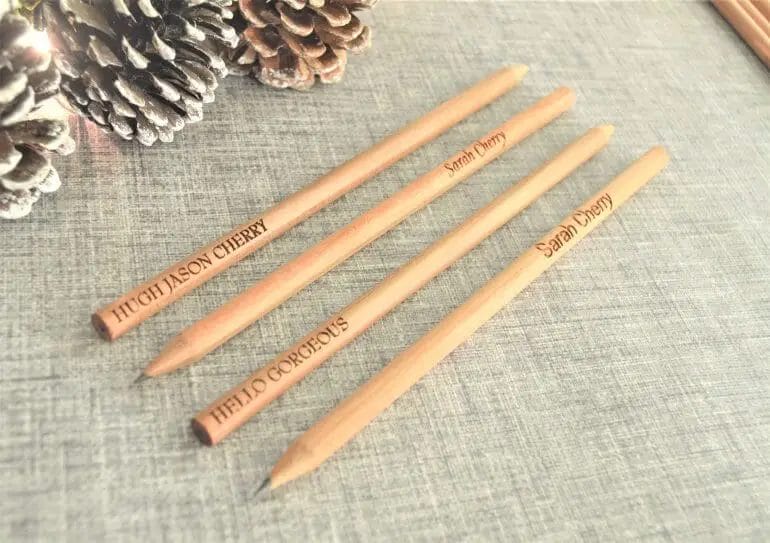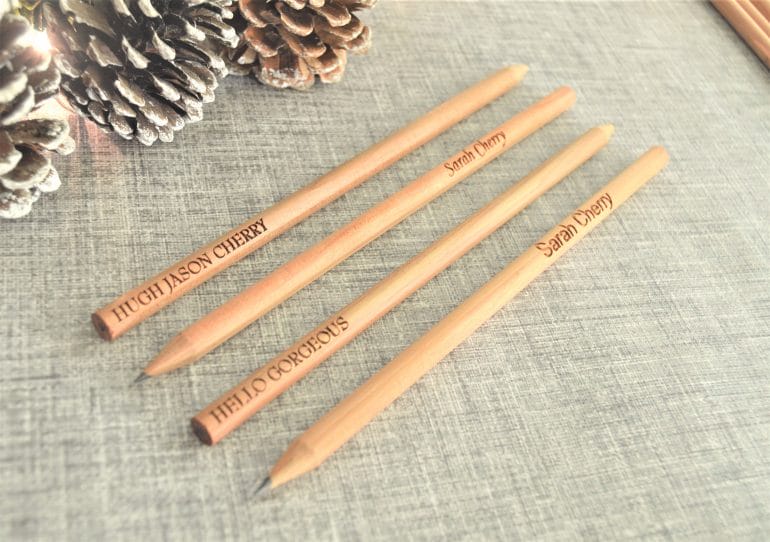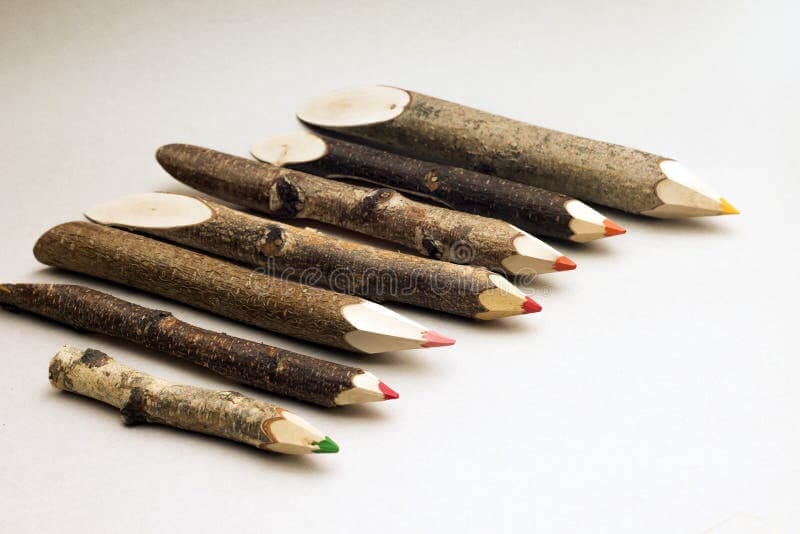Pencils are typically made from a versatile and widely used type of wood called cedar. This type of wood is valued for its smooth texture and ability to hold a sharp point, making it perfect for writing and drawing. The use of cedar wood in pencil production has been a longstanding tradition due to its durability and ease of sharpening. However, pencils can also be made from other types of wood, such as basswood or poplar, depending on the manufacturer’s preferences and the desired quality of the pencil.

The Importance of Choosing the Right Wood for Pencils: A Guide for Artists and Writers
When it comes to creating art or writing, the choice of materials plays a crucial role in the quality and outcome of your work. One often overlooked aspect is the wood used in pencils. The type of wood used can significantly impact the performance, durability, and overall experience of using a pencil. In this guide, we will explore the importance of choosing the right wood for pencils and how it can enhance your artistic or writing journey.

1. Understanding the Different Types of Wood
Cedar: Cedar wood is one of the most popular choices for pencil manufacturing. It offers a perfect balance of flexibility and hardness, making it ideal for smooth and precise lines. Cedar has a fine grain structure, which allows for easy sharpening and creates a smooth writing or drawing experience.
Basswood: Basswood, also known as linden wood, is another common wood used in pencil production. It is lightweight, soft, and easy to sharpen, making it a favored choice for artists and writers. Basswood pencils are known for their smoothness and ability to hold a sharp point for a longer time.
Fir: Fir wood, with its high durability and strength, is often used in more robust pencils. It is known for its resistance to breakage and ability to withstand pressure, making it a suitable choice for artists working on detailed and intricate illustrations.
Poplar: Poplar wood is a versatile option, commonly used in budget-friendly pencils. While it may not offer the same level of performance as cedar or basswood, it still provides a satisfactory writing or drawing experience. Poplar pencils are a popular choice for beginners and those who prefer a softer lead.
2. Factors to Consider When Choosing the Right Wood
Now that we have covered the different types of wood used in pencils, it is essential to consider certain factors when selecting the right wood for your needs:
- Pencil Purpose: Determine whether you intend to use the pencil for writing, sketching, or detailed illustrations. This will help you narrow down the wood type that suits your requirements.
- Lead Hardness: Different woods may complement different lead hardness levels. Softer woods like cedar or poplar are often paired with softer leads, while harder woods like fir are used with harder leads.
- Preference: Personal preference also plays a significant role. Some artists and writers may prefer the smoothness of cedar, while others may enjoy the lightweight feel of basswood.
3. Benefits of Choosing the Right Wood for Pencils
Choosing the right wood for your pencils can have several advantages:
- Enhanced Performance: The right wood can enhance the performance of your pencil by providing the ideal balance of flexibility and hardness.
- Improved Durability: Choosing a wood known for its strength and resistance to breakage ensures that your pencils last longer, reducing the need for frequent replacements.
- Enhanced User Experience: Different woods offer unique tactile sensations and smoothness, allowing for a more enjoyable and comfortable writing or drawing experience.
- Precision and Control: The properties of the wood can affect the sharpening ability and the pencil’s ability to hold a sharp point, enabling precise and controlled lines.
Summary
The choice of wood in pencils may seem like a small detail, but it can greatly impact your artistic and writing endeavors. By understanding the different types of wood, considering key factors, and recognizing the benefits of choosing the right wood, artists and writers can enhance their creative journeys and achieve better results. So next time you pick up a pencil, remember to consider the wood that lies beneath the lead.

Sustainable Wood Options for Eco-Friendly Pencils: Making a Positive Impact on the Environment
In today’s world, where sustainability and environmental conservation have become paramount, it is crucial to explore eco-friendly alternatives in every aspect of our lives. Even something as simple as a pencil can have a significant impact on the environment. Traditional pencils are often made from wood sourced from deforestation practices, leading to habitat loss and carbon emissions. However, there are sustainable wood options available that can help mitigate these negative effects and make a positive impact on the environment. Let’s explore some of these sustainable wood options for eco-friendly pencils.
1. FSC-Certified Wood
The Forest Stewardship Council (FSC) is an international non-profit organization that promotes responsible forest management. By choosing pencils made from FSC-certified wood, you can be assured that the wood used is sourced from sustainably managed forests. FSC certification ensures that forests are managed in an environmentally responsible, socially beneficial, and economically viable manner. These pencils are a great choice for environmentally conscious individuals who want to support sustainable forestry practices.
2. Recycled Newspaper Pencils
Recycled newspaper pencils are an ingenious alternative to traditional wooden pencils. These pencils are made from tightly rolled and compressed recycled newspaper. By repurposing newspapers that would otherwise end up in landfills, these pencils help reduce waste and conserve resources. They are also an excellent way to promote recycling and raise awareness about the importance of waste management.
3. Bamboo Pencils
Bamboo is a fast-growing, renewable resource that makes it an excellent choice for eco-friendly pencils. Unlike hardwood trees that take decades to mature, bamboo can be harvested in just a few years. It is known for its durability, strength, and natural beauty. Bamboo pencils offer a sustainable alternative to traditional wooden pencils, as bamboo plantations can be easily replenished, making them an environmentally sound option.
4. Plantable Pencils
Plantable pencils are not only sustainable but also have an added benefit of contributing to reforestation efforts. These pencils are made from biodegradable materials such as sustainably sourced wood or recycled paper. At the end of their life, instead of throwing them away, you can plant them in soil. The pencil contains a seed capsule at the end, which germinates and grows into a plant. This innovative concept combines functionality with environmental consciousness and can make a significant positive impact on the planet.
5. Certified Recycled Wood Pencils
Certified recycled wood pencils are another eco-friendly option for those seeking sustainable alternatives. These pencils are made from wood scraps and offcuts from other industries that would otherwise go to waste. By repurposing these materials, we can reduce the demand for virgin wood and minimize the environmental impact associated with traditional wooden pencils. Opting for certified recycled wood pencils supports the circular economy and helps conserve natural resources.
Choosing sustainable wood options for eco-friendly pencils is a simple yet effective way to make a positive impact on the environment. By opting for pencils made from FSC-certified wood, recycled newspaper, bamboo, plantable materials, or certified recycled wood, we can reduce deforestation, promote responsible forest management, and contribute to reforestation efforts. Each small step towards sustainability counts, and using eco-friendly pencils can be a significant one. Let’s make conscious choices to protect our planet for future generations.

Comparing Different Types of Wood for Pencil Making: Which is the Best Choice?
When it comes to pencil making, the type of wood used plays a crucial role in determining the quality and performance of the pencil. Different types of wood have different characteristics that can affect the durability, smoothness, and overall writing experience of the pencil. In this section, we will compare and analyze the various types of wood commonly used in pencil making to determine the best choice.
1. Cedar Wood
Cedar wood is one of the most popular choices for pencil making due to its excellent properties. It is lightweight, which makes it easy to handle and maneuver while writing. Cedar wood also has a straight grain, allowing for smooth and effortless sharpening. Additionally, it has natural oils that help reduce friction, resulting in a smooth writing experience. The combination of these factors makes cedar wood pencils a favorite among artists, students, and professionals alike.
2. Basswood
Basswood is another widely used wood in pencil making. It is known for its light color, which allows for easy identification of pencil marks on paper. Basswood has a soft and uniform texture, making it ideal for creating smooth and consistent lines. However, its softness can also lead to quicker wear and tear compared to other types of wood. Despite this, basswood pencils are still favored for their ease of use and affordability.
3. Poplar Wood
Poplar wood is often chosen for its strength and durability. It is a relatively hard wood that can withstand heavy use without breaking or splintering easily. Poplar wood pencils are known for their longevity and resistance to damage, making them a reliable choice for those who need a pencil that can withstand rigorous use. However, poplar wood can be slightly heavier than cedar or basswood, which may affect the overall comfort of writing for some individuals.
4. Incense Cedar
Incense cedar, also known as Calocedrus decurrens, is a type of cedar wood known for its exceptional quality. It shares many similarities with traditional cedar wood, including its lightweight nature, straight grain, and natural oils. Incense cedar pencils offer a smooth writing experience and are favored by artists and professionals who require precision and control. While incense cedar may be slightly more expensive than other types of wood, its superior performance makes it a worthwhile investment.
5. Other Wood Options
While cedar, basswood, poplar, and incense cedar are the most commonly used woods in pencil making, there are other wood options available as well. These include pine, fir, and spruce, among others. Each wood type has its own unique characteristics and may offer a slightly different writing experience. It is important to consider factors such as smoothness, durability, and personal preference when choosing a wood type for pencil making. Trying out different options can help determine the best choice for individual needs.
Summary
Choosing the right type of wood for pencil making is essential for ensuring a high-quality and enjoyable writing experience. Cedar wood is favored for its lightweight nature, straight grain, and smooth sharpening properties. Basswood offers a soft and uniform texture, while poplar wood provides durability and resistance to damage. Incense cedar is known for its exceptional quality and precision. Ultimately, the best choice of wood for pencil making may vary depending on personal preference and specific requirements.
Innovative Alternatives to Wood for Pencil Manufacturing: Exploring Synthetic and Recycled Materials
Wood has been the traditional material used for manufacturing pencils for centuries. However, with increasing concerns about deforestation and sustainability, there is a growing demand for innovative alternatives to wood in the pencil industry. In this section, we will explore some synthetic and recycled materials that can be used as a sustainable substitute for wood in pencil manufacturing.
Synthetic Alternatives
One of the most promising synthetic alternatives to wood for pencil manufacturing is plastic. The use of plastic not only reduces the dependency on wood but also offers several advantages. Plastic pencils are more durable and long-lasting compared to their wooden counterparts. They are resistant to breakage and can withstand rough handling. Additionally, plastic pencils can be easily molded into various shapes and sizes, allowing for greater design flexibility.
Another synthetic material that has gained popularity in recent years is metal. Metal pencils are known for their durability and strength. They are less prone to breakage and can last longer than wooden pencils. Metal pencils also offer a sleek and modern aesthetic, making them a preferred choice for artists and professionals.
Recycled Alternatives
Recycling materials for pencil manufacturing not only reduces the demand for new resources but also helps in waste reduction. One of the most common recycled materials used in pencils is newspaper. The newspaper is compressed into a solid core and then coated with a protective layer, creating a sustainable and eco-friendly pencil. These recycled newspaper pencils are not only environmentally friendly but also offer a unique texture and writing experience.
Another recycled material that has gained traction in recent years is denim. Denim pencils are made from discarded denim fabric, which is shredded and mixed with other materials to create a pencil core. These pencils not only contribute to waste reduction but also offer a unique and stylish alternative to traditional wooden pencils.
Benefits of Innovative Alternatives
The adoption of synthetic and recycled materials for pencil manufacturing offers several benefits. Firstly, it reduces the dependency on wood, thereby reducing deforestation and preserving natural resources. Secondly, these alternative materials are often more durable and long-lasting, resulting in less waste. Thirdly, the use of innovative materials provides greater design flexibility and allows for the creation of unique and aesthetically appealing pencils. Lastly, utilizing recycled materials helps in waste reduction and promotes a circular economy.
In summary, the pencil industry is exploring innovative alternatives to wood for manufacturing pencils. Synthetic materials like plastic and metal offer durability and design flexibility, while recycled materials like newspaper and denim contribute to waste reduction and sustainability. By embracing these innovative alternatives, the pencil industry can reduce its environmental impact and move towards a more sustainable future.
FAQs
What wood are pencils made of?
Pencils are typically made from cedar wood. Cedar wood is preferred for its lightweight, smooth texture, and easy sharpening.
Conclusion:
In conclusion, pencils are primarily made from different types of wood, with each variety offering its unique properties and characteristics. The most commonly used wood for pencil production is the California incense-cedar, renowned for its smoothness and durability. Other types of wood used include basswood, poplar, and fir. The choice of wood depends on factors such as hardness, strength, and availability. While technology has introduced synthetic alternatives, wooden pencils remain popular due to their natural feel and environmental sustainability.
Wooden pencils continue to be a versatile and essential tool, utilized by artists, students, and professionals around the world. Whether it’s sketching, writing, or shading, the wooden casing provides a comfortable grip and precise control. The use of wood in pencil manufacturing not only supports the sustainability of forests but also ensures the longevity and reliability of this timeless writing instrument.